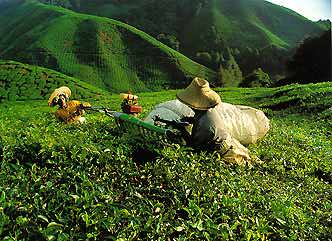Pests And Diseases
The tea plant is subject to attack from at least 150 insect species and 380 fungus diseases. In Northeast India, where 125 pests and 190 fungi have been detected, losses from pests and diseases have been estimated at 67000000 pounds (30000000 kg) of tea per annum. More than 100 pests and 40 diseases occur in the tea fields of Japan. Sri Lanka, where estates are close together or contiguous, has recorded many blights and suffered serious losses.
Africa has little trouble with blights. The tea mosquito (Helopeltis theivora) is the only serious pest. The Caucasus, with a climate similar to that of Japan, grows the China variety of plant and has no serious pests or blights.
Blight control has become highly developed. Northeast Indian scientists have issued a list of 40 approved proprietary pesticides. Some of these pesticides cannot be applied during the plucking season; others require that the two subsequent rounds of weekly pluckings be discarded.
General Physical Growth Factors:
Case Study: Malaysia

Background:
The first tea plant grown commercially in Peninsula Malaysia from China, as early as in the seventeenth century. However, it was only in the early twentieth century that tea cultivation became important. The tea that was grown in the early twentieth century was imported from India. The variety of tea, known as the Assam variety, is still grown in Peninsula Malaysia. The tea produced is sold locally and overseas.
Where the Tea Plantations are found:
The main tea growing areas are located in the Cameron Highlands, in the state of Pahang. Here, tea is grown at an elevation of 1000m to 1700m above sea level. The remaining tea growing areas are found in lowland areas, mainly in the states of Selangor and Perak. The favourable physical conditions present in the Cameron Highlands - abundant rainfall, long hours of sunshine and well-drained acidic soils, have contributed to its importance as a tea growing area in Malaysia. The main type of tea produced in Peninsula Malaysia is black tea.
Back to Top